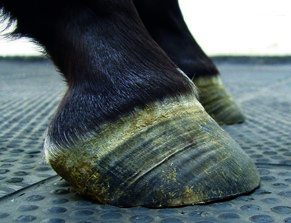ARCHIVE EQUINE NEWS STORIES
| Current news is available at TheHorsePortal.ca, Equine Guelph's online learning platform for practical, quick learning. Given the vast amount of information on horse health and welfare, Equine Guelph has archived its past news articles from 2002-2020. They are listed below, along with a search function available to find specific healthcare topics. | |
Have you tested your Laminitic Horse For PPID?August 2019
Don’t ignore the signs – get checked with this amazing program.
Story by: Jackie Bellamy Zions
 Guelph, ON – Pituitary Pars Intermedia Disfunction (PPID), also known as Equine Cushing's Disease, is a top cause of laminitis and often isn't tested when laminitis presents. During September and October, Boehringer Ingelheim Animal Health Equine will offer horse owners across Canada over 1000 free PPID tests in partnership with the Guelph Animal Health Laboratory. Interested horse owners simply need to go to BICanadaEquine.ca, answer a short PPID knowledge quiz and then complete the application form.
Guelph, ON – Pituitary Pars Intermedia Disfunction (PPID), also known as Equine Cushing's Disease, is a top cause of laminitis and often isn't tested when laminitis presents. During September and October, Boehringer Ingelheim Animal Health Equine will offer horse owners across Canada over 1000 free PPID tests in partnership with the Guelph Animal Health Laboratory. Interested horse owners simply need to go to BICanadaEquine.ca, answer a short PPID knowledge quiz and then complete the application form.
Changes in hair coat and changes in body conformation are well known as signs of PPID but laminitis is a key warning sign not to be overlooked, especially if it is recurrent, chronic or of insidious onset. In one study, it is estimated that up to one third of all laminitis cases may suffer from PPID! Another study cites 90% of laminitis cases can be attributed to an underlying endocrinopathy.
The best rule of thumb is when you see symptoms of laminitis, talk to your veterinarian about testing for PPID.
Laminitis can have many different causes and finding out the root of the cause is of utmost importance to prevent further episodes. Horses suffering from laminitis will usually be reluctant to move and often stand with their front feet well out in front of them, rocking back on their heels seeking relief from the pain. They can appear as if they are ‘walking on eggshells’. The hoof will be hot to touch. In severe cases the laminae weakens to the point where the coffin bone may rotate and/or sink.
It is important to dispel the myth that "PPID is a hairy horse disease for older horses."
Although PPID is a very common disease more often seen in horses 15 years of age and older, but it can occur in horses as young as 10. Signs are often overlooked and dismissed as part of the aging process but an early diagnosis is very important and can lead to a very good prognosis. Certain studies have reported signs of improvement within three months of treatment in horses with PPID.
Veterinarians take initial blood tests to measure levels of various hormones or markers to confirm the presence or absence of PPID. It is the hope of Boehringer Ingelheim Equine that more horse owners will take this first step as a result of the awareness spread through their PPID testing campaign.
“Every fall Boehringer Ingelheim sponsors a PPID testing campaign in partnership with Animal Health Laboratory.” says Doug Myers, DVM, Boehringer Ingelheim Animal Health. “Over the past five years, more than 1700 horses have been tested and 62% were positive for PPID.”
For more information on the free PPID testing campaign, go to BICanadaEquine.ca
The Senior Horse Challenge Tool on Equine Guelph’s website also contains activities where you can check your savvy at picking up on subtle changes that may lead to early detection of metabolic disorders such as PPID.
Photo Credit: Boehringer Ingelheim Equine
Photo Caption: The best rule of thumb is when you see symptoms of laminitis, you should test for PPID.